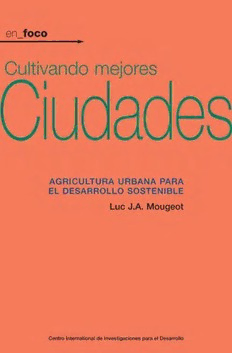
Cultivando Mejores Ciudades: Agricultura urbana para el desarrollo sostenible PDF
134 Pages·2006·0.646 MB·Spanish
Most books are stored in the elastic cloud where traffic is expensive. For this reason, we have a limit on daily download.
Preview Cultivando Mejores Ciudades: Agricultura urbana para el desarrollo sostenible
Description:
This is the Spanish edition of "Growing Better Cities". The United Nations predicts that over the next 25 years nearly all population growth will be in the cities of the developing world. At current rates, 60% of the world’s total population will live in cities by 2030. As the cities grow, so does the number of urban poor. Unemployment, hunger, and malnutrition are commonplace. In the big city, most of any cash income the poor might bring home goes to feeding themselves and staying alive; any food that does not have to be bought is a bonus. As a result, more and more people are attempting to grow at least some of their own food to supplement poor diets and meager incomes. But farming in the city — urban agriculture — is too often seen by municipalities as a problem to be eradicated rather than as a part of the solution to making the city and its environment more sustainable.In fact, urban agriculture has a long history. Throughout the developing world, municipal policymakers are waking to the fact that properly managed agriculture can make a major contribution to a city’s food security. It also has potential to provide employment, improve the environment, and make productive use of vacant spaces within the city. More than 20 years ago, IDRC became the first international agency to formally support research on urban agriculture. This book reviews the research experience of IDRC and its partners, including local governments, into the issues surrounding urban agriculture, with a particular emphasis on the influence that research has had on government policies. It describes the growth of city networks in Africa and Latin America that focus on accommodating urban agriculture and improving the lot of urban food producers. And it offers specific recommendations aimed at helping policymakers at all levels of government to maximize the potential of urban agriculture. The book concludes with a vision of how such policies might transform cities in the near future.This book serves as a focal point for an IDRC thematic Web site on urban agriculture. The full text is available online and leads the reader into a virtual web of resources that explores two decades of research into this important issue.
See more
The list of books you might like
Most books are stored in the elastic cloud where traffic is expensive. For this reason, we have a limit on daily download.
